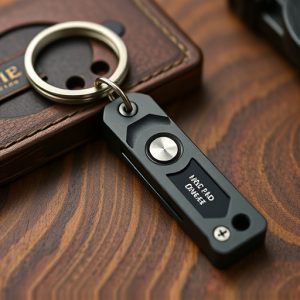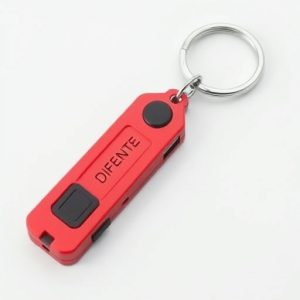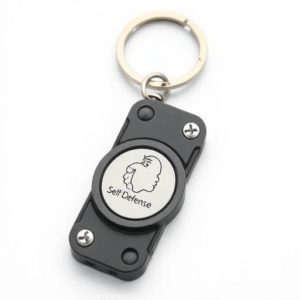Tactical Keyring: Crafting a Secure, Durable Self-Defense Tool
When designing tactical keyring weapons for self-defense, choosing durable materials like stainless…….
When designing tactical keyring weapons for self-defense, choosing durable materials like stainless steel, titanium, heat-treated steel, durable plastics, and composites is essential. These materials ensure longevity, performance, and reliability in various environments, providing peace of mind during critical situations. The optimal blend of these robust materials creates a powerful, yet comfortable self-defense tool that maintains its sharpness, strength, and grip over time.
“Unleash your tactical advantage with the ultimate self-defense keyring. In a world where preparedness is key, exploring durable materials like high-quality steel and aluminum offers a solid foundation for these compact weapons. This article delves into the art of crafting a secure grip, revealing ergonomic designs that ensure control during critical moments. Discover how cutting-edge technologies transform traditional gear, presenting innovative materials that offer both strength and lightness. We balance practicality with size, providing insights to create effective, yet keyring-sized self-defense tools.”
- Choosing the Right Materials for Durability
- – Discussing the importance of durable materials in tactical keyring designs
- – Exploring options like high-quality steel, aluminum, and hard plastics
- Ergonomic Design for Secure Grip
Choosing the Right Materials for Durability
When designing a self-defense keyring with a tactical grip, selecting the right materials is paramount to ensure durability and functionality. Opting for high-quality metals like stainless steel or titanium guarantees resistance to corrosion and wear over time. These materials are particularly beneficial for keyring weapons due to their strength and ability to maintain sharp edges for effective defense.
For an extra layer of protection, consider incorporating heat-treated steel components, which enhance toughness and reduce the risk of breakage during use. Additionally, durable plastic or composite materials can provide a comfortable grip while adding weight to improve balance and control. Choosing the right combination of these durable materials will ensure your keyring weapon stands the test of time and remains reliable in various self-defense scenarios.
– Discussing the importance of durable materials in tactical keyring designs
In the realm of tactical gear, durability is a cornerstone. When it comes to keyring-based self-defense tools, durable materials are not just a preference—they’re a necessity. The ability to withstand rigorous use, extreme conditions, and even impact can mean the difference between a reliable defense and a compromised tool. Materials like high-strength steels, advanced alloys, and robust composites offer exceptional strength-to-weight ratios, ensuring your keyring weapon remains functional in the most demanding situations.
Choosing durable materials for keychain weapons isn’t just about brute force; it’s also about longevity. A well-crafted tactical keyring should resist wear and tear, corrosion, and even accidental drops. This not only provides peace of mind but also guarantees that your self-defense tool will be by your side when you need it most, ready to serve its purpose with unwavering reliability.
– Exploring options like high-quality steel, aluminum, and hard plastics
When designing a tactical keyring with self-defense capabilities, choosing the right materials is paramount to ensuring durability and effectiveness. High-quality steel offers exceptional strength and resilience, making it ideal for impact-based defenses. Look for options like stainless steel or high-strength carbon steel, which can withstand frequent use and extreme conditions without compromising sharpness or integrity.
Aluminum and hard plastics are also viable choices for durable materials in keyring weapons. Aluminum alloys provide a balance between weight and strength, making them lightweight yet sturdy. Hard plastics, such as reinforced polycarbonate or nylon, offer excellent impact resistance and can be molded into intricate designs. These materials are less prone to rust compared to steel, making them suitable for diverse environments, from outdoor adventures to everyday carry situations.
Ergonomic Design for Secure Grip
An effective self-defense keyring requires a thoughtful design that combines functionality and comfort. One crucial aspect is an ergonomic grip, ensuring the user has a secure and stable hold even in stressful situations. The tactical grip design focuses on providing a comfortable yet firm grasp, allowing users to quickly deploy the tool without slipping or tiring their hands. This is especially important when the keyring is made for self-defense purposes, where every second counts.
Durable materials play a significant role in achieving this ergonomic design. High-quality metal alloys and robust synthetic compounds ensure the keychain’s grip remains consistent over time, even with frequent use. These materials not only enhance the overall durability but also contribute to the keyring’s longevity, making it a reliable companion for personal safety.
When crafting a self-defense keyring with a tactical grip design, prioritizing durable materials is paramount. High-quality steel, aluminum, and robust hard plastics offer exceptional strength and longevity, ensuring your keychain weapon stands the test of time. An ergonomic grip further enhances usability, providing a secure and comfortable hold for whenever you need to defend yourself. Investing in these features translates to peace of mind, knowing that your self-defense tool is as reliable as it is compact.


